Setting Up Your Class
Discover all the ways you can personalize the financial simulation to achieve your specific teaching objectives and student outcomes.
Create A New Session
If you just registered as a professor, you will have the option to create your first session from the confirmation page. Click Create New Session.
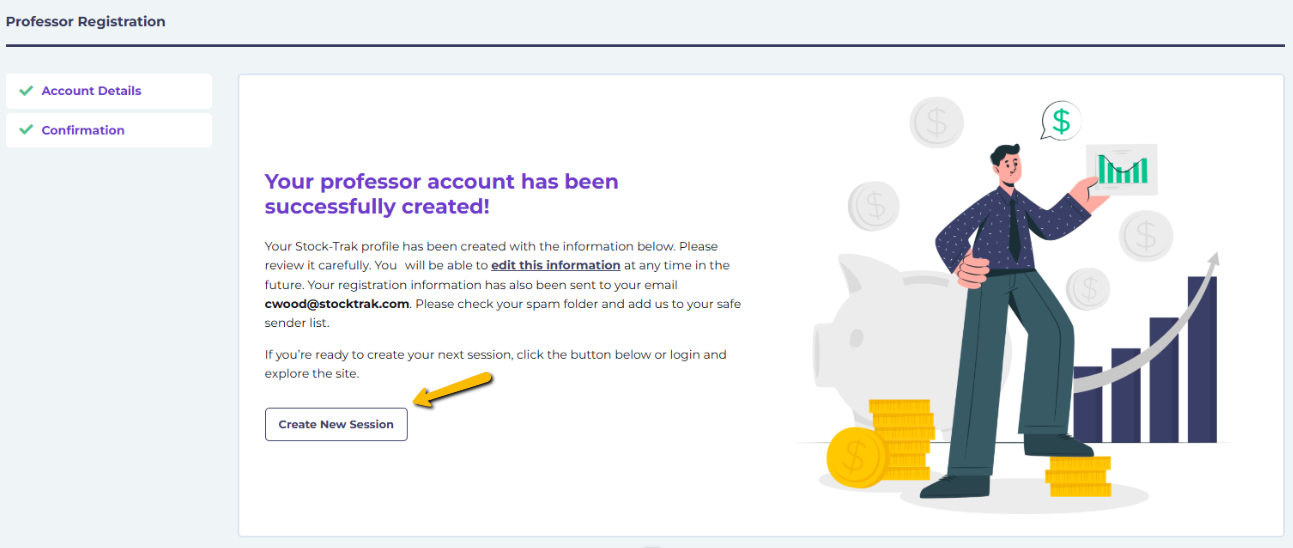
Otherwise, you can create a session by clicking:
- Admin tab on the Main Menu.
- Click Create A New Session.

To get more information on how to use our Reports and Edit Trading Rules for existing classes Click here to learn more.
Service Level
- To get access to the Budgeting Game, Select Personal Finance.
- Click Investments or Portfolio Management to access all securities and exchanges.
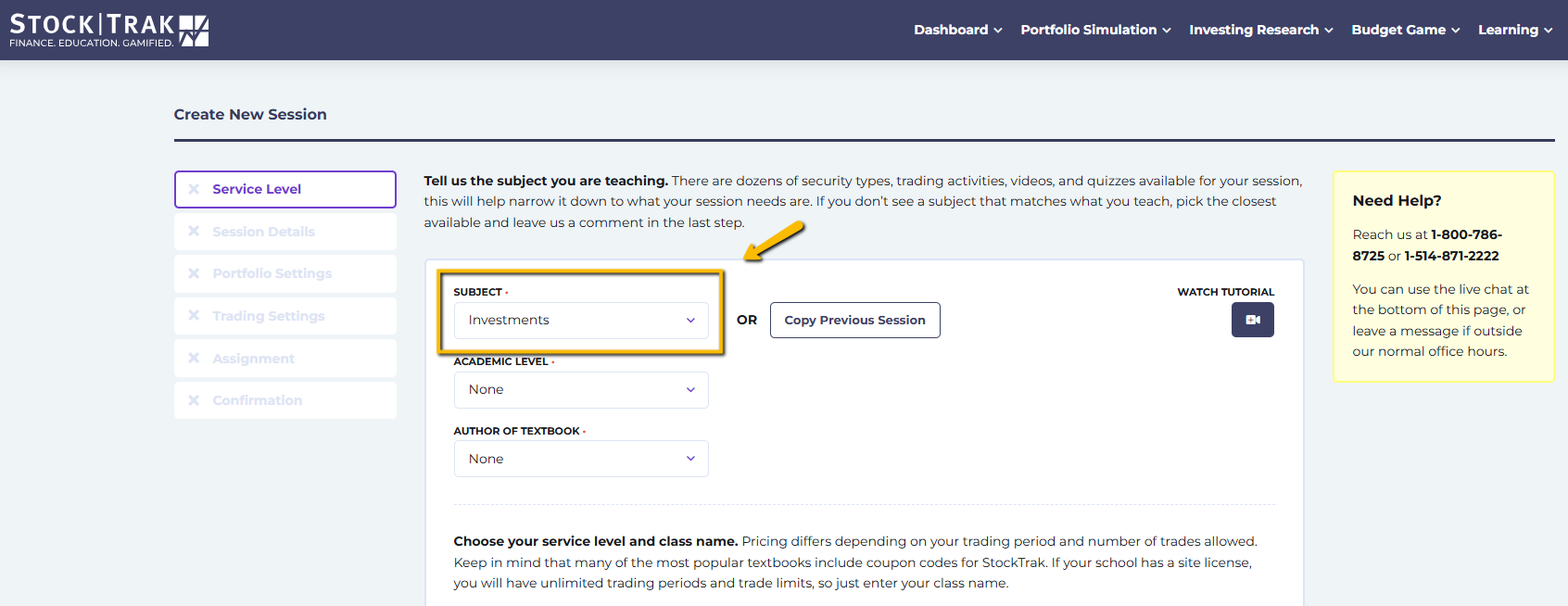
Your service level will determine the maximum length of your class, and the maximum number of trades each student can make.
To add a promotional code from a textbook, make sure to select the author’s name from the dropdown menu.
If you have a site license, you will not be asked for a service level. Site license clients have no restrictions on class lengths and no trade caps (although we can add trade limits to your class if you like).
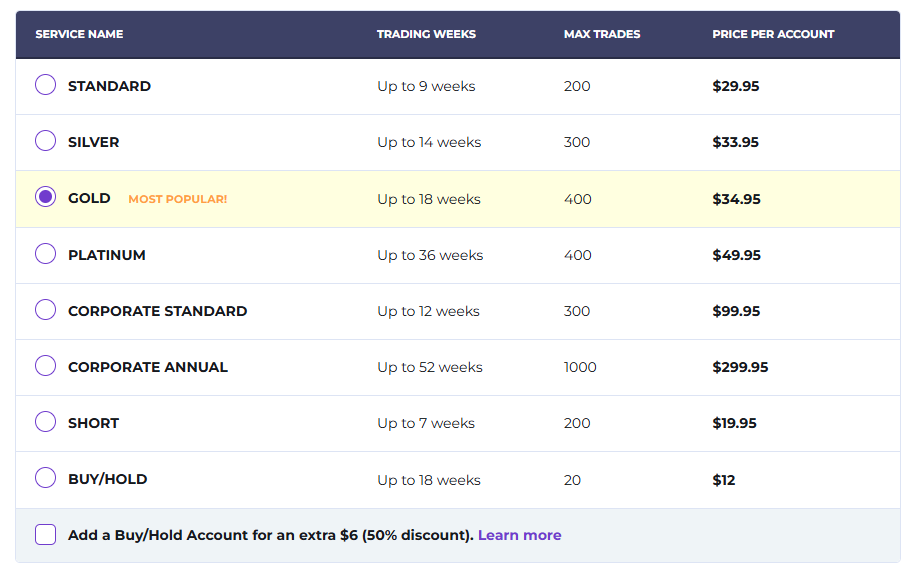
You can add a Buy and Hold portfolio to most other service levels for $6 per student account. This allows your students to manage an active and passive portfolio simultaneously.
Payment Method
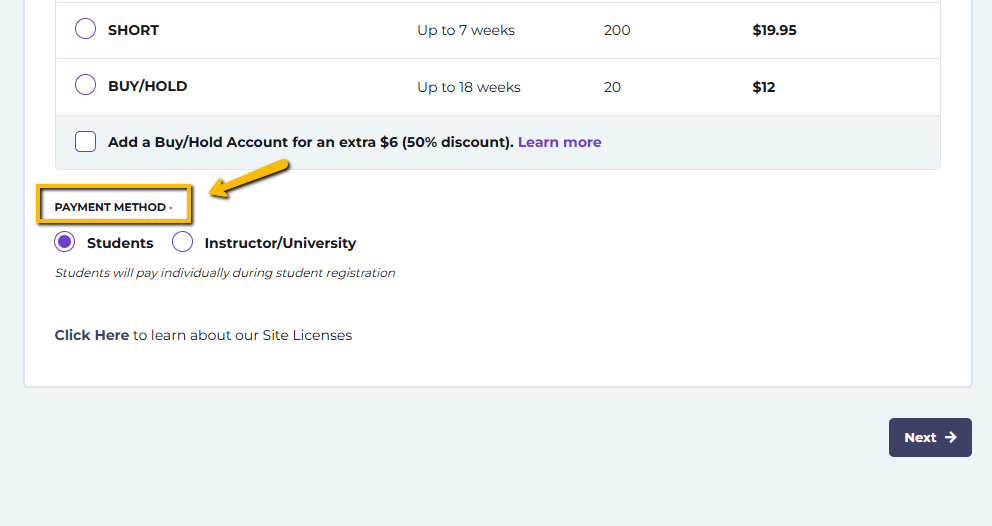
If you choose Instructor/University payment type, we will send you an invoice based on your estimated number of students. We will send you two invoices – one immediately after you create your class based on your student estimate, and a second after your trading has begun based on the total number of student accounts that were actually created.
Many investment textbooks contain coupons for StockTrak. Your students would enter these coupon codes at registration if you selected Students as the payment method.
Session Details

- Session Name: this is the name of your class or session, this is what your students and you will see as your class name. e.g. Fall 2025 – FIN 101 or ECON 450 or Stock Market Enthusiasts.
- Registration Start/End Dates: these are the dates that your students can register into your class. Outside of these dates, no new students can join (we can change this later if needed).
- You can set your registration dates independently of your trading dates.
- Trading Start/End Dates: these are the dates that students can actually trade in their portfolios. After the tournament end date, all values are frozen as of the market close on the last trading day, along with the rankings. So students do not need to worry about selling off all their positions at the end.
- Number of Students in Class: some instructors organize their students into teams with multiple students on one account. We ask you put the total number of students who will be using the platform, this way we know how many students are engaging with the site.
- Time Zone: this will have no impact on the time stamps taken throughout the site.
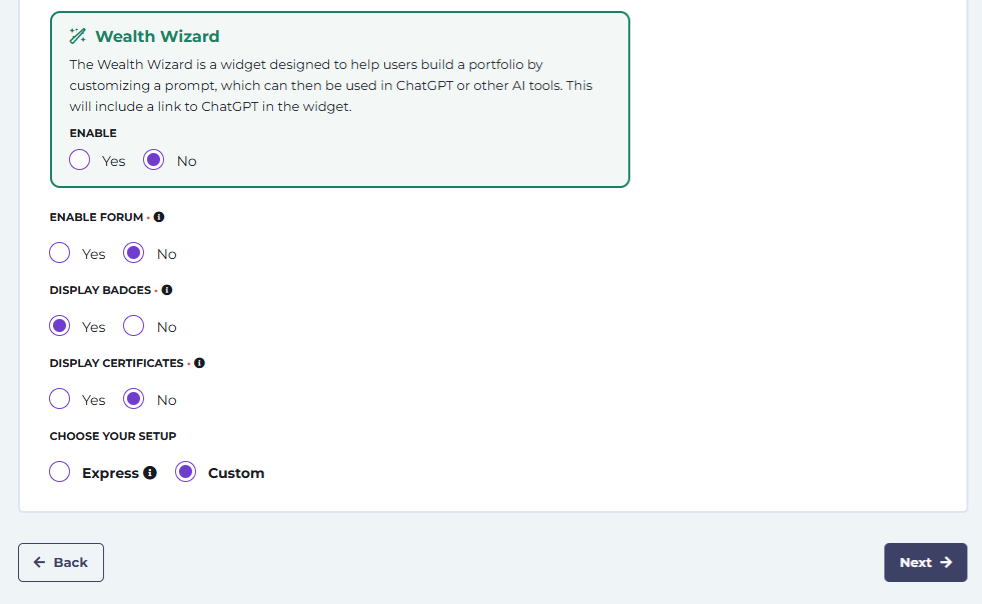
- Wealth Wizard: with this enabled, students can make their own customizable prompts to build and manage their portfolio. These prompts help them use AI tools like ChatGPT, Gemini, Llama, or Claude. The widget itself links to ChatGPT (OpenAI).
- Enable Forum: you can turn this on or off at any time, and it appears on your dashboard after logging in. Students can leave comments or questions to the class, and each class has their own forum.
- Display Badges: students will earn Badges from all actions they perform in the game.
- Display Certifications: upon completing our core curriculum, (if selected from the assignments creation section) your students can earn a certificate in Investing101 – Beginner’s Investing or a Financial Literacy Certification.
- Choose Your Setup: If you want to use the recommended settings, choose the Express button and go straight to the assignment set-up. To customize your portfolio and trading settings keep Custom selected and click, Next.
Portfolio Settings
Next, you will select the settings for your class or session.
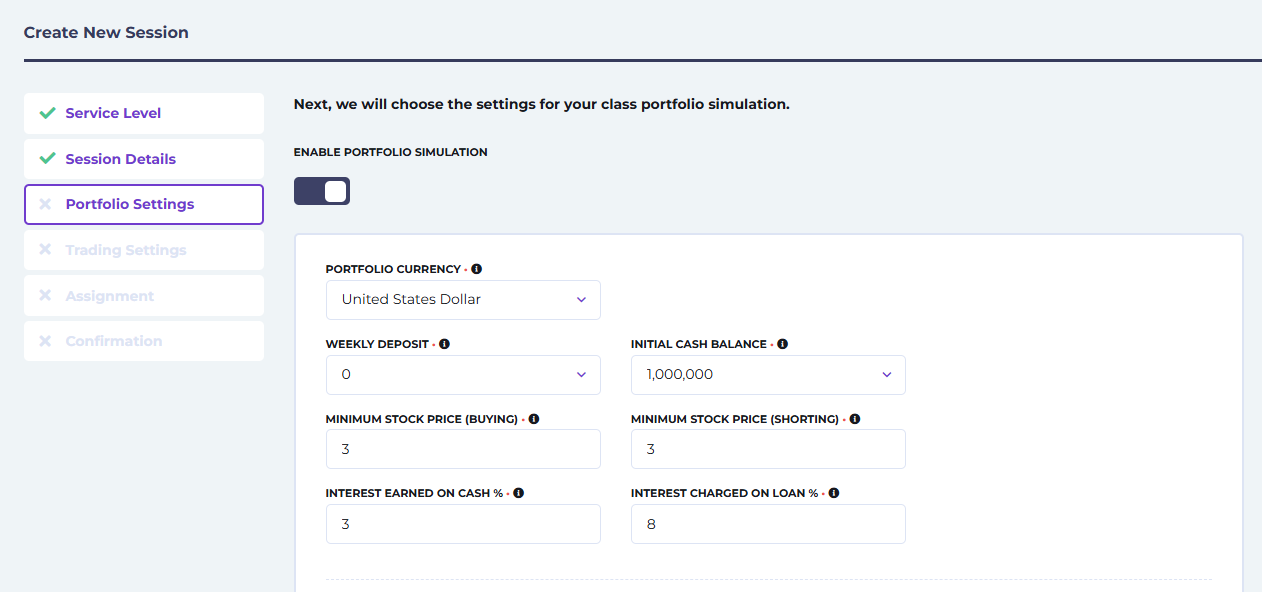
- Portfolio Currency: this is the currency your students will be trading in. This cannot be changed later.
- Weekly Deposit: allows your students to receive new money in their accounts at the start of each week. You can turn this on or off at any time. TIP: these deposits can recreate what real investors do each month as they put money aside to invest in their portfolios to save up for retirement or some other large purchase.
- Initial Cash Balance: this is your student’s starting cash; in the currency you chose above.
- Minimum Stock Price (Buying): some professors don’t want their students playing with penny stocks, this lets you put a price floor on what students can buy.
- Minimum Price (Shorting): same as above but applies to short selling. If you want to disable short selling entirely, that has a separate rule below.
- Interest Earned on Cash %: the default setting is 3%, which will mean that students will earn 3% by doing nothing with their initial cash. TIP: to encourage them to invest you can decrease this to 1% or even use negative integers!
- Interest Charged on Loan %: the default setting is 8%, and this applies if you enable trading on margin.
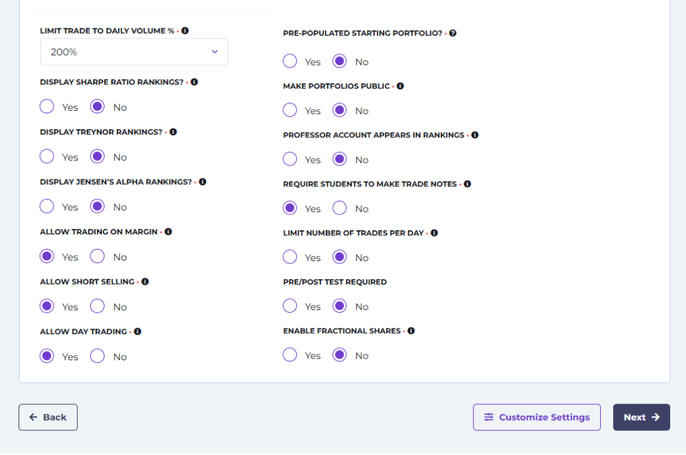
- Limit Trade to Daily Volume %: this is a liquidity parameter, and it compares the quantity your students attempt to trade against the current day’s trading volume of a security in the real world. This comes mostly into play with options trading. With a 200% rule, if a security has a volume of 10, your students can buy or sell up to 20 in one day.
- Display Alpha/Beta Rankings (or Sharpe Ratio): this is for advanced tournaments; it will allow you to rank your students by risk-adjusted returns.
- Alpha/Beta works best for US equity portfolios, since we may not have the Beta available for all international equities or other security types.
- Allow Trading on Margin: this will allow students to trade on margin and borrow money based on their asset value. If students borrow money, they will be charged interest (8% annual interest rate, compounded daily by default, but this can be changed if you ask our support team).
- Allow Short Selling/Day Trading: this will dictate whether or not your students can short sell or day trade respectively. If day trading is disabled, students will not be able to buy and sell the same stock in the same day.
- Pre-Populated Starting Portfolio: if you want to have your students start with the same collection of securities you will need to turn this on and contact your account manager or reach out to our support team at support@stocktrak.com with the list of stocks, bonds, mutual funds etc. to be included.
- Make Portfolios Public: turn this setting on to allow your students to review each others’ holdings.
- Professor Account Appears in Rankings: you can turn this on or off at any time. TIP: student engagement increases when they’re competing with their professor.
- Require Students to Make Trade Notes: if enabled students will need to justify each of their trades before executed. TIP: they can be exported along with the historical transactions at the end of the semester to create reports on their investment strategies and how it changed over time.
- Limit Number of Trades per Day: you can specify how many trades students can make per day if you choose Yes.
- Pre/Post Test Required: If toggled on, this will require students to complete a financial literacy test at the beginning and end of your session to gauge their understanding of core concepts.
- Enable Fractional Shares: If enabled, students can buy portions of a single share of a stock or ETF. (Example: Instead of buying 1 share, they could buy 0.5 shares). If disabled, they must buy whole shares.
Trading Settings
When you get to the Trading Settings page, you can either click Next if you want to keep the Default Recommended Settings. Otherwise, click Customize Settings to choose your own security types and exchanges.
Choose from:
- Stocks
- ETFs
- Cryptos
- Mutual Funds
- Bonds
- Options
- Futures
- Futures Options
- Forex
- Cash Spots
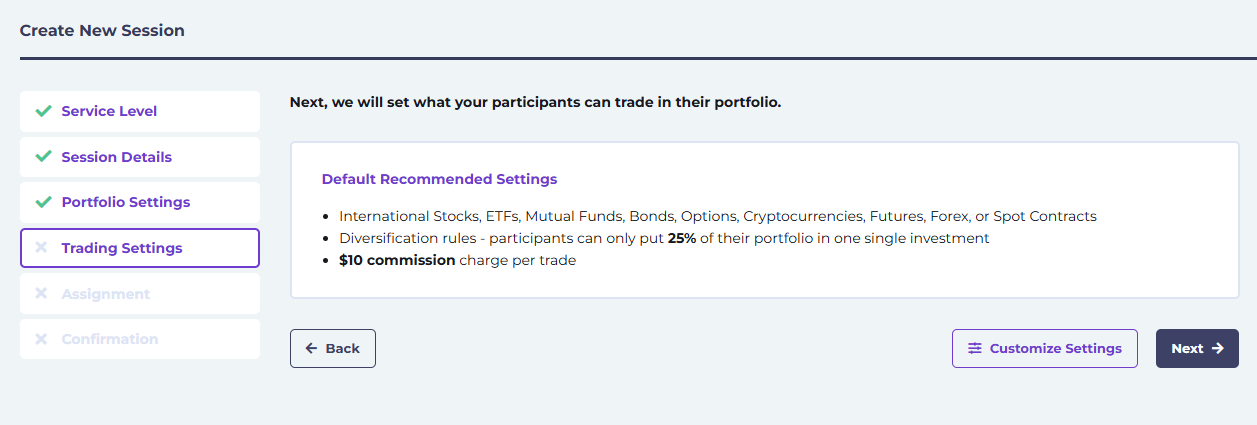
- Security types: You can choose between equities, mutual funds, options, futures, future options, bonds, and spot contracts (gold, oil, currencies) too. You can also set different commission charges, and the way commissions are charged (per trade, per share, or as a percentage of the total order).
Please note that futures trading is only available to academic customers.
- Commission: You can also set the commission structure independently for each security type (for example, $10 per trade for Stocks, but $0.50 per contract for Options).
- Position Limit: this is how much a student can invest in one company or ticker symbol based on the current portfolio value. For example, with $100,000 as the initial cash, a 20% position limit will mean students can invest $20,000 in any company/equity/mutual fund etc.
- Diversification: this is how much a student can invest in one asset class. So, if you set this to 50% for equities/stocks, your students will have to either keep the balance of their portfolio in cash or invest in other security types. TIP: If you have margin trading enabled, you’ll want more than 100% enabled or else they will not be able to use their loan to invest in more securities.
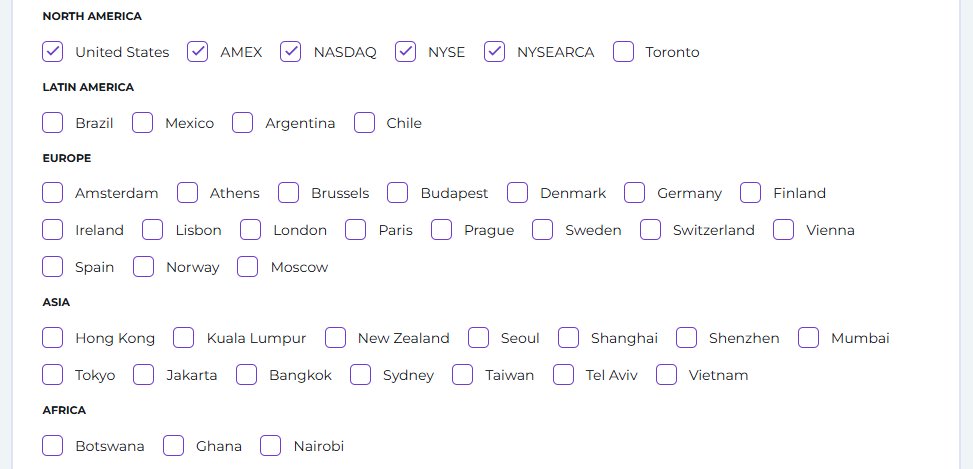
- Allowed Exchanges: we currently only support international securities for equities, spots (for currency trading), and futures (mutual funds, bonds, and options are US-only).
You can select all the exchanges, by clicking the button at the top, or individually select any of the available options below. Please contact our support team if you need any assistance at support@stocktrak.com.
Assignments
We have a guide dedicated to setting up your assignments, click here to learn more.
Assignments are list of tasks you give your students to complete, for example:
- Read Articles
- Watch Tutorial Videos
- Completing Tasks
You can track their progress from the Assignment Report Card page.
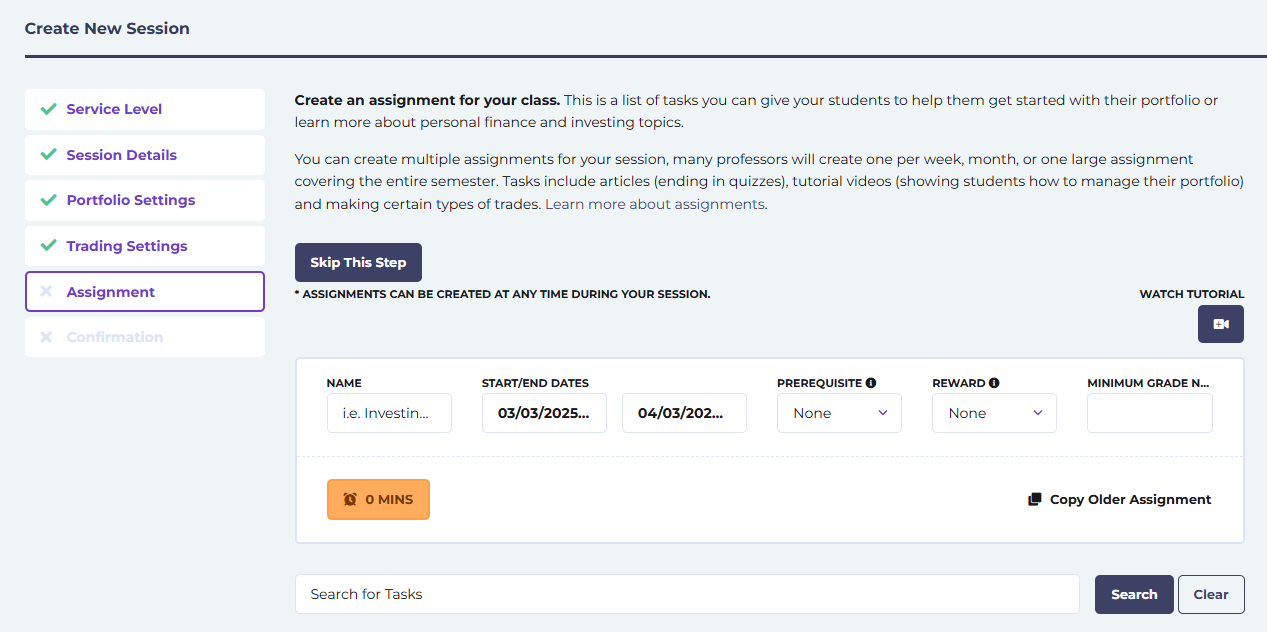
If you’re not ready to set-up your assignment right away, you can Skip this Step.
To create an assignment after registering your class, click Create a New Assignment from the Admin tab on the main menu. This is also where you’ll be able to edit previous assignments and get progress reports on your students’ grades.
When you are finished, click Create Session at the bottom of the page. Once your class is set up, you can view reports, edit rules, and much more. Click here to see how.
Class Confirmation
Once you’ve completed all these steps, you’ll be taken to the Confirmation Page. You will also receive a copy by email.
Share the Registration Link with your students so they can join your session.
You can also set-up a demo account for either yourself or your TA. You can use this to trade alongside your students, or to set-up benchmark portfolios in the rankings. You can have two demo accounts per class. Click Get Accounts to generate 1-2 demo accounts.
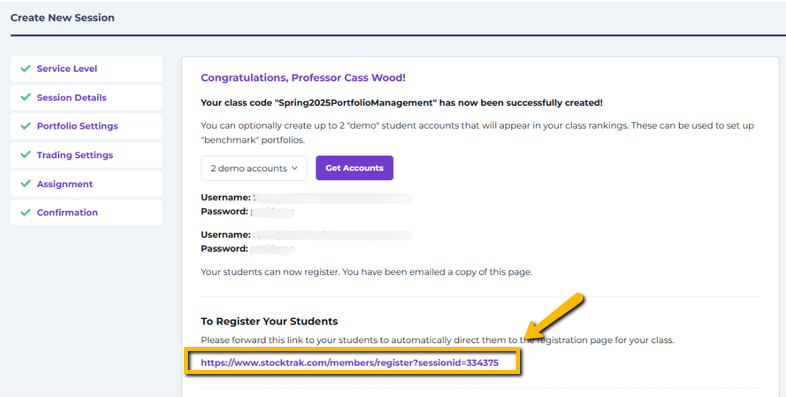

Need Some Help?
We hope this guide has helped you set-up your class or session on StockTrak. If you have questions about best practices for setting up your class, or any other aspect of the platform, we have resources ready to assist you.
Get Answers Quickly:
Check our Professor FAQStill Need Assistance?
Phone Number: 1-514-871-2222 (9:00 AM – 5:00 PM EST)
Toll Free: 1-800-786-8725
Email: support@stocktrak.com